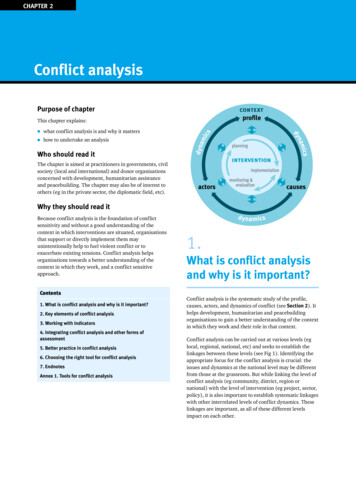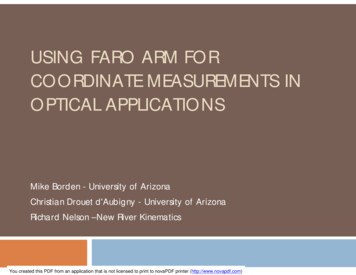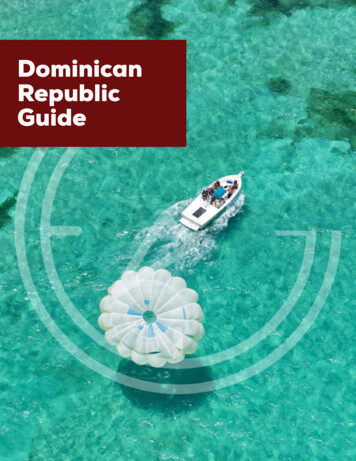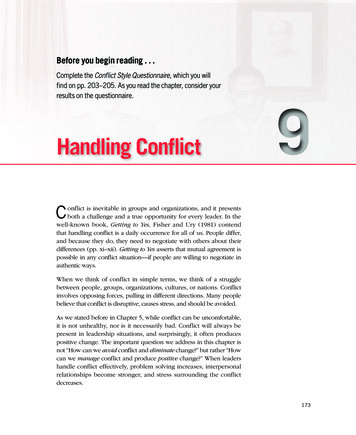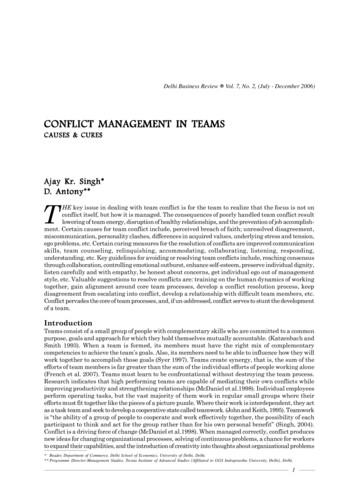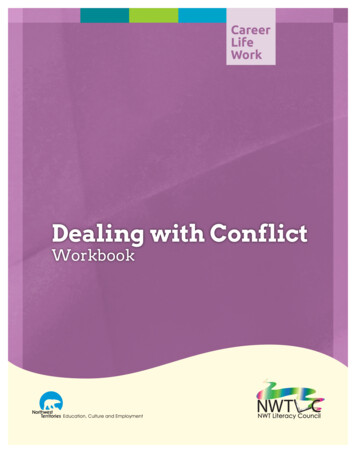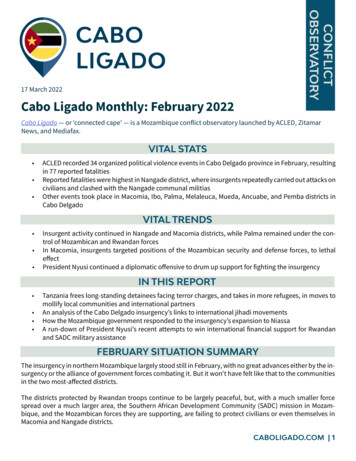
Transcription
CONFLICTOBSERVATORY17 March 2022Cabo Ligado Monthly: February 2022Cabo Ligado — or ‘connected cape’ — is a Mozambique conflict observatory launched by ACLED, ZitamarNews, and Mediafax.VITAL STATS ACLED recorded 34 organized political violence events in Cabo Delgado province in February, resultingin 77 reported fatalitiesReported fatalities were highest in Nangade district, where insurgents repeatedly carried out attacks oncivilians and clashed with the Nangade communal militiasOther events took place in Macomia, Ibo, Palma, Melaleuca, Mueda, Ancuabe, and Pemba districts inCabo DelgadoVITAL TRENDS Insurgent activity continued in Nangade and Macomia districts, while Palma remained under the control of Mozambican and Rwandan forcesIn Macomia, insurgents targeted positions of the Mozambican security and defense forces, to lethaleffectPresident Nyusi continued a diplomatic offensive to drum up support for fighting the insurgencyIN THIS REPORT Tanzania frees long-standing detainees facing terror charges, and takes in more refugees, in moves tomollify local communities and international partnersAn analysis of the Cabo Delgado insurgency’s links to international jihadi movementsHow the Mozambique government responded to the insurgency’s expansion to NiassaA run-down of President Nyusi’s recent attempts to win international financial support for Rwandanand SADC military assistanceFEBRUARY SITUATION SUMMARYThe insurgency in northern Mozambique largely stood still in February, with no great advances either by the insurgency or the alliance of government forces combating it. But it won’t have felt like that to the communitiesin the two most-affected districts.The districts protected by Rwandan troops continue to be largely peaceful, but, with a much smaller forcespread over a much larger area, the Southern African Development Community (SADC) mission in Mozambique, and the Mozambican forces they are supporting, are failing to protect civilians or even themselves inMacomia and Nangade districts.CABOLIGADO.COM 1
The stretch of the N380 highway between Macomia town and the village of Chai was particularly targeted inFebruary, something which continued into March. The area is largely empty of civilians, a situation the government hoped to have reversed by now, but insurgents have been attacking military positions there, killing andmutilating at least two members of Mozambique’s security and defense forces.An operation by Mozambican and Rwandan troops in early February, to clear insurgents out of western Palmadistrict, appears to have triggered an increase of attacks on villages in Nangade, as insurgents moved westwards out of Palma. In contrast to the joint force with the Rwandans in Palma, the SADC forces in Nangade— mainly Tanzanians, with some from Lesotho — appear to have largely stood by as villages were attackedand civilians killed. Villages have again emptied of civilians, who have fled to the main village of the district —which has so far remained safe, though undoubtedly vulnerable.Neither the SADC nor the Rwandan missions gained any new clarity on how they will be funded going forward,despite two trips by Mozambican President Filipe Nyusi to Brussels, amid hopes that the EU would providefinancial assistance for one or both of the deployments.TANZANIA RELEASES PRISONERS HELD ON TERROR CHARGESBy Peter Bofin, Cabo LigadoAt least 160 people who had been remanded on terrorism charges, some for as long as seven years, were released from detention in February. On 23 February, one of the largest reported refugee crossings took placejust one week before a “Joint Protection Dialogue” between the United Nations High Commissioner for Refugees (UNHCR) and the government of Tanzania’s ministries of foreign affairs and home affairs. Both issuespaint a picture of the country’s response to the conflict in Cabo Delgado, and its impact on Tanzania. PresidentSamia Suluhu Hassan’s approach to political engagement, both domestic and international, is more openthan that of her predecessor, but political progress on both fronts will come slowly.The prisoner releases indicate the scale of the terrorist threat perceived by Tanzania and provide insight intothe processes leading to the releases. Between 23 February and 3 March, 160 people, nearly all men, werereleased. A further 20 were released in Morogoro, but immediately re-arrested. Inconsistent reporting and anCABOLIGADO.COM 2
absence of any official statements mean the actual basis on which they were released cannot be determinedclearly. Some had charges dropped and some were released on binding orders as investigations continued,while the basis of the release of others was not made clear. The lack of extensive coverage, after reports of therelease of the first four detainees, illustrates the nervousness felt by mainstream media in dealing with terrorism-related issues. After reports on the first releases in Mtwara on 23 February, and later Dar es Salaam, mostreports of the releases were to be found on social media.The releases come after two years of campaigning and lobbying by loose networks of Muslim activists on behalf of detainees, some of whom have been awaiting trial since 2013. Their total number is not known, but itis estimated as being in the hundreds. The releases give an insight into how the state brings Islamist-orientedactivists into mainstream political processes at the national and the local level.In June 2020, the Shura ya Maimamu, or Advisory Council of Imams, produced a position paper for that year’sgeneral election, which called for the release of 148 people detained on terrorism charges between 2013 and2017, whose cases had yet to come to trial. The following month Hizb Ut Tahrir launched a campaign for the release of four of its members detained in Mtwara. In August 2020, five months after coming into office, PresidentSamia herself called for the release of those who have been detained on remand for years while their cases areinvestigated.Shura ya Maimamu is associated with Sheikh Ponda Issa Ponda, who has a history of conflict with the stateand the National Muslim Council (known by its Kiswahili acronym Bakwata), and has been arrested numerousCABOLIGADO.COM 3
times. He claims to have met with the Director of Public Prosecutions (DPP) in January, stating that the DPPtold him that all those held on long remand were due for release. Ponda had also last year undertaken a seriesof prison visits and meetings with prisoners’ relatives. Internal DPP processes continued in February, according to Mtwara’s resident magistrate-in-charge, and other channels were employed, too. In Morogoro, a sheikhheading up the Kamati ya Maafa ya Mkoa, or Regional Emergencies Committee, the body supporting Muslimsdetained on terrorism charges in Morogoro, claims to have been in direct contact with the DPP on the issue.These civil society processes have recorded a significant win. There is no evidence that other prisoners awaiting trial have benefited in this way. Given the numbers involved, they will go some way to building bridges withaffected communities, though elsewhere disappearances have continued, and continue to be highlighted.Building bridges with the international community with regard to Tanzania’s refugee policy will be a similarly slow affair, despite the High Level Protection Dialogue held from 1 to 2 March with UNHCR. Tanzania’srelations with UNHCR have been strained since a 2019 agreement between Burundi and Tanzania to forciblyreturn refugees who are in camps in Kigoma region.Relations have been further strained with the policy of refoulement of refugees from the conflict in Cabo Delgado. In April 2021, a group of UN human rights experts alleged that refugees from Burundi were subject toenforced disappearances, torture, and forced return. The following month, UNHCR expressed concern overTanzania pushing refugees fleeing fighting in Cabo Delgado back across the Mozambique border. This followed a UNHCR estimate in April that up to 1,000 refugees who fled the attack on Palma had been subject torefoulement.Since then, refugee flows have continued, despite military intervention by Rwandan and SADC forces. As inKigoma, Tanzania is reluctant to see permanent refugee settlements develop, seeing them as a security risk.Whether that policy will contribute to increasingly suspicious views of SADC troops — in Nangade district inparticular — remains to be seen.TRANSNATIONAL JIHADISM ANDINSURGENCY IN CABO DELGADOBy Liazzat J. K. Bonate, lead researcher on Cabo Delgado at Norway’s Christian Michelsen Institute, andlecturer in African History at the University of the West Indies (UWI), St Augustine in Trinidad and TobagoThe violent insurgency in the coastal province of Cabo Delgado in northern Mozambique began inOctober 2017, when some young Muslims stormed police stations in the city of Mocímboa da Praia. In 2019,the Islamic State (IS) began claiming responsibility for attacks in Cabo Delgado, and posted a video of theinsurgents tak-ing an oath of allegiance to the leader of IS. The conflict appears to be a resistance againstthe Mozambican state, and an irregular insurgency in a classical sense, with prolonged political-militaryactivity through the use of irregular forces and illegal political organizations. Actions such as guerrillawarfare, terrorism, propa-ganda, clandestine recruitment, and international networking are designed toweaken the state’s control and its legitimacy. But the allegiance to IS also suggests that the insurgency islinked to transnational jihadism.Transnational jihadism is a type of violent activism that is inherently “glocal” (global/local), because,although jihadists oppose nation states on the basis of local grievances, they also challenge theinternational order of Western hegemony. Transnational jihadism has three key elements: 1) it is anideology based on a radical in-terpretation of the fundamental sources of Islam; 2) it seizes on localgrievances, especially against the state, to trigger an insurgency or channel the existing resistance to its ownbenefit; and 3) it also resists and rejects the Western-dominated global order. All three of these elementsappear to be present in Cabo Delgado, but detailed research is still lacking. The affiliation of the insurgentswith IS indicates that they met the criteria ex-pected by that organization. As Candland, Finck, and Ingramdescribe, the IS propaganda organs showed that they were accepted and Cabo Delgado was formallyincorporated into IS’s Central African Province.CABOLIGADO.COM 4
Transnational groups like IS emerged from Islamist ideologies, which attempt to articulate Islam into a political order. Islamism has roots in Salafism and in a mixture of Wahhabi doctrine and the interpretations of SayyidQutb (1906-1966), who emphasised takfir, and violent jihad. The former is the judgement of other Muslims asnon-believers to be excluded from Islam for inadequate adherence to a rigid interpretation of Islam. The warin Afghanistan from 1978 to 1992 brought new ideologues to the fore, such as Ayman Al Zawahiri, a student ofQutb. Al Zawahiri insisted that the “far enemy” — the United States — was equal to the “near enemy,” its localpuppets, constituting a system which Al Zawahiri called “veiled colonialism.” The US invasion of Iraq in 2003gave rise to Al Qaeda in Iraq, which adopted brutal tactics and an extreme position on dealing with non-believers, and which ultimately led to the emergence of IS.African jihadists have also participated in these global discussions and transnational wars. The Armed IslamicGroup (GIA) of Algeria gave birth to Al Qaeda in the Islamic Maghreb (AQIM) in 2001, which soon moved intoMali, Niger, and Chad. Somalia’s Harakat Al Shabaab was established in 2006 and the group declared allegiance to Al Qaeda in 2012 — the same year in which the jihadist group Al Hijra from Kenya did so. Boko Haramemerged in 2002 and 2003 in Nigeria and pledged allegiance to IS in 2015. It later split into two, with one wingbecoming the Islamic State of West Africa Province (ISWAP) in 2016. As Candland, Finck, and Ingram note, theAllied Democratic Forces (ADF) of Uganda launched in 1995 and became affiliated with IS in 2019.While global activism changed the nature and scale of local protests, Africa’s jihadist movements remain deeply rooted in specific local socio-political settings and fights. To successfully expand in a given region, transnational jihadism requires ideological protagonists, and an enabling and fertile environment for exploring emotional entry points. A landmark early report into the insurgency by Habibe, Forquilha, and Pereira suggested itmay have been initiated by Mozambican Salafis, who were influenced by northern Mozambicans schooled inIslamist ideology and transnational jihadism at Islamic universities abroad. They channeled resistance to theolder generation of Salafis, and expressed dissatisfaction with the socio-economic situation of the country, inparticular in the north. But subsequent studies on the matter provide no clear empirical evidence to supportthis hypothesis, nor do they unveil insurgents’ discourses and narratives.It is also not clear whether Cabo Delgado insurgents had been in contact with regional or global jihadist movements before 2017 with the intention of starting an armed revolt. This is certainly a possibility, given that thenorthern coast of Mozambique has been part of the Swahili and the Indian Ocean commercial and cultural networks for centuries. However, radical jihadist movements were already present in Somalia, Kenya, theDemocratic Republic of Congo, Uganda, Comoros, and Tanzania by the 1990s, and violent jihad did not emergein Mozambique before 2017. As Luca Raineri explains, the abuses perpetrated by state authorities ― includingallegations of corruption, systematic discrimination, arbitrary arrests, extrajudicial executions, etc. ― are themain drivers of jihadism.The Cabo Delgado insurgency started in a very specific region and time; it emerged in the gas-producing regions of Mocímboa da Praia, and Afungi in Palma, amid expectations of an economic boom resulting from theconstruction of a gas processing complex there. In many oil and gas producing societies, violent extremism isgenerated by real or perceived grievances, such as discrimination, marginalization, injustice, repression, andother abuses by the state and security apparatus, which have exacerbated pre-existing grievances. This is alsonoticeable in Tanzania, where — similar to Cabo Delgado — there are high rates of unemployment and povertyin Muslim coastal areas. The Muslim communities of both regions likely influence each other’s position regarding the postcolonial state, neoliberalism, and transnational jihadism.Furthermore, establishing the oil and gas industry in Cabo Delgado has been surrounded by controversy because of alleged patronage and corruption and because of growing inequality. This negative popular perception was further compounded by the belief that most jobs in the new industry appeared to go to foreigners andMozambicans from the south of the country, rather than young local Muslims, whose hopes for employmentand a better future had been dashed. This served as emotional, fertile ground for an insurgency directed notCABOLIGADO.COM 5
only against the Mozambican state and its allies, but also against the global hegemony of the West — embodied by the extractive companies.Islamist ideology, in its many forms, remains attractive to some circles of the resistance, who seize, transformand reinterpret it. Even if IS disappears, jihadist ideology will live on and be carried forward by other Islamists.Military assaults to eliminate transnational jihadism, therefore, might not defeat the jihadists. In the case ofCabo Delgado, only the future will reveal the true impact of the continuing military intervention.GOVERNMENT RESPONSE TO NIASSA ATTACKSBy Tomas Queface, Cabo LigadoIn late November 2021, armed violence in Cabo Delgado spread to neighboring Niassa province, confirmingthe fears of the Mozambican police, SADC, and warnings from analysts, of a possible insurgent expansion intothat province. The attacks took place in November and December 2021, centered on Mecula district. How thegovernment responded to the expansion of the insurgency in Niassa, and the security and humanitarian challenges that emerged from this, is a question that deserves detailed analysis.Although insurgent attacks had been confined to Cabo Delgado province, researchers have noted that Niassaand Nampula provinces — in addition to being fertile environments for insurgent recruitment — share similar social dynamics with Cabo Delgado. These dynamics, which encourage insurgent growth and expansion,include organized crime networks, porous borders (in Niassa and Cabo Delgado), high poverty rates, and authoritarian government rule. For the Mozambican police, the expansion of the insurgency was seen from astrategic point of view, as Niassa and Cabo Delgado share the same border. Meanwhile, at the same time as theauthorities were looking at strengthening security as a way to contain attacks on Cabo Delgado province, theNorthern Integrated Development Agency (ADIN) was created in March 2020 to address the socio-economicchallenges of the north, with a focus on Nampula, Cabo Delgado, and Niassa provinces.The arrival of foreign troops from Rwanda and SADC changed the dynamics of the conflict. The Rwandansexpelled the insurgents from Palma and Mocímboa da Praia. The insurgents dispersed in small groups to thesouth towards Macomia and to the west towards Nangade. SADC forces, who were operating in Macomia andNangade, noted the flight of insurgents south of the Messalo River, particularly into Niassa province. As expected, insurgents began a series of attacks in Niassa, first in the area of Gomba — 150km from the districtheadquarters of Mecula — on 25 November, with an attack on a vehicle in the Niassa Special Reserve. Two dayslater, the insurgents attacked a police post in Naulala, 60km from Mecula village. Houses were destroyed andgoods and medicines were looted. The next day, they returned to Naulala where they continued looting goodsand medicines. On 30 November, insurgents attacked a Mozambican security forces truck 20km from Mecula.Insurgent attacks in Niassa continued until 27 December with the attack on the village of Alassima, duringwhich insurgents killed five people, kidnapped others, and burned houses.The series of attacks by insurgents was enough to convince Mozambique’s defense minister of their presencein Niassa. The national police commander, however, had confirmed in December the presence of insurgents inNiassa, claiming that they entered through the district of Mavago, west of Meluco. In the same statement, thecommander announced the death of an insurgent leader in Niassa, Maulana Ali Cassimo — a native of the province. Prior to his radicalization and decision to join the insurgency, Maulana worked as a civil servant in Melucodistrict, Niassa. The response of the authorities to the insurgent attacks in Niassa was to immediately deploylarge numbers of police and army reinforcements. Questions about whether Mozambique had enough officersand soldiers to provide security in the area, as well as the failure to adequately respond to the insurgency inCabo Delgado, raised the prospect of foreign troops being deployed in the area, particularly from Rwanda, butthese were denied by the authorities.The president of Mozambique has been very vocal about the insurgent attacks in Niassa. In his year-end speechCABOLIGADO.COM 6
to the nation on 16 December 2021, President Filipe Nyusi, said the attacks on Niassa were a result of pressurefrom joint and combined Rwandan and SADC forces in Cabo Delgado, and that the militants would naturally beon the run, to Niassa or even Tanzania to the north. In the same speech, Nyusi appealed to the population notto panic and gave assurances that the security forces would be on the offensive pursuing the insurgents. Onhis trip to Mecula, the epicenter of the attacks in Niassa, the Mozambican president asked the population notto abandon the areas under attack because the defense and security forces were there to provide protection.And, according to Nyusi, it was due to these security forces that the spread and intensification of insurgentattacks in Niassa were prevented.One of the major effects of the insurgent activity in Niassa was the displacement of people in the region. Atleast 3,700 internally displaced people, mostly from Naulala and surrounding areas, arrived in the main townof Mecula. Others headed to the districts of Senga, Mecanhelas, Marrupa, and to the provincial capital, Lichinga. The depopulation of several villages continued until January 2022. The government, through the NationalInstitute for Disaster Management, accommodated the displaced people in temporary locations.The lack of food support and shelter, Nyusi’s call for displaced people to return, and the need to resume theiractivities in their areas of origin caused many displaced people to leave the accommodation centers and headfor their homes in early February 2022. The decision to return was also reinforced by the fact that there havebeen no attacks in Mecula for more than a month. The provincial government even promised support in theprocess of rebuilding the homes of the displaced populations in some villages that suffered attacks. But civilians have complained about a lack of transparency in the reconstruction process. ADIN opened its first officein Niassa in February 2022 to remedy social inequality and to promote socio-economic development. To whatextent ADIN will make a short-term impact on the ground, and to what extent the Mozambican defense forceswill guarantee protection to Niassa, will depend on the dynamics of the conflict in the neighboring Cabo Delgado province and the insurgents’ ability to threaten the northern part of the country.NYUSI SEEKS TO SHORE UP CABO DELGADO SUPPORTBy Piers Pigou, Cabo LigadoFebruary saw Mozambican President Filipe Nyusi traveling widely in a bid to secure further support and funding for operations against the insurgency in Cabo Delgado. He met regularly with African allies and ended themonth with the prospect of further EU support appearing positive.His February travels came after a January in which Maputo was involved in major security discussions withcontinental partners, with allies committing to extending support for counter-terrorism efforts in northernMozambique. These discussions included the SADC summit, the Rwanda-Mozambique security summit in Kigali, and meetings with the AU’s Peace and Security Council. Nyusi also hosted Tanzanian President SamiaSuluhu Hassan and TotalEnergies CEO Patrick Pouyanné. Both visits focused on developments in the securitysituation in Cabo Delgado.This set the scene for a busy month of travel in February for Nyusi, who was intent on exploring additionalsources of funding for counterinsurgency operations and reassuring investors and partners over the currentapproach to the northern insurgency. South African President and chairperson of SADC’s Organ for Politics,Defence and Security Cyril Ramaphosa on 3 February visited troops from the SADC Mission in Mozambique(SAMIM) for the first time since their deployment. Joining Heroes Day commemorations in Mueda, Ramaphosaemphasized South Africa’s long-standing ties to Mozambique, but made little public reference to the actualconflict.Nyusi was in Addis Ababa for the Heads of State and Government session on 4 February and 5 February, whichaffirmed AU solidarity with Mozambique’s campaign against violent extremism, and commended both SADCCABOLIGADO.COM 7
and Rwanda for their support. The AU also called on the continent and international community to supportMaputo to “effectively counter terrorism.” No further detail was included in the AU’s summit document, Decisions, Declarations, Resolution and Motion.After the summit in Addis Ababa, Nyusi flew directly to Brussels for a three-day visit, where he held discussionswith EU leaders, including the EU High Representative for Foreign Affairs and Security Policy Josep Borrell andEuropean Council President Charles Michel. Among the topics under discussion, Nyusi made a specific requestfor the EU to go beyond the support it provides through its existing military training mission program, to support the security deployments of Rwanda and SADC in Cabo Delgado. With AU endorsement and the EuropeanPeace Facility (EPF) offering greater flexibility on funding options, some support to Rwanda can be expected,although it is unlikely to satisfy Kigali and Maputo’s requirements. It is likely to be only non-lethal support. Asraised in an edition of Cabo Ligado weekly last month, SADC is yet to apply for EPF funding and is instead applying for more limited support through the EU’s Emergency Response Fund. The EU has emphasized it retainsan integrated approach to its support, which incorporates development and humanitarian support. Beyondmilitary training, the EU has approved 428 million ( 474.5 million) of funding to cover cooperation for the firstfour years of the 2021-2027 EU-Mozambique cooperation cycle.It is unclear whether any Rwandan or SADC officials joined Nyusi to help make the case for supporting bothmissions. Nyusi returned home via Kigali, where he met with President Paul Kagame, discussed progress onoperations in Cabo Delgado, and presumably reported on progress from the Brussels trip. The EU representative in Rwanda Nicola Bellomo reportedly confirmed that the EU is in discussions with Rwanda “to determineneeded support to its interventions in Mozambique.”Zimbabwean President Emmerson Mnangagwa was in Beira on 12 February on a working visit to Mozambique, which was focused on deepening economic relations. Zimbabwe’s precise role in supporting theSAMIM initiative remains unclear. During the visit, Mnangagwa announced that Zimbabwe would donate 1,000 tonnes of grain to Cabo Delgado as part of a humanitarian drive to support people living there.While sources have confirmed that Zimbabwe Defence Forces have given limited training support to forcesfighting the insurgency, exactly what this means remains unclear. Zimbabwe has not deployed as part of theSAMIM force in Cabo Delgado and it is unclear if and how this training is linked to other training missions, suchas the EU Training Mission in Mozambique and the United States’ Joint Combined Exchange Training program.Nyusi was back in Europe a few days later on 17 and 18 February, this time with other African leaders, to attend the sixth EU-Africa summit convened in Brussels. The meeting failed to deliver concrete outcomes, yetcovered a raft of topics, including “peace, security and governance.” The summit’s final declaration includedan undertaking to build AU-EU cooperation that will help “combat instability, radicalization, violent extremismand terrorism.” The final declaration also included a “commitment to foster our cooperation through supportfor adequate training, capacity building and equipment, to strengthen and scale up autonomous peace operations of African defense and security forces, including through EU missions and assistance measures, as wellas support for law-enforcement capacity-building.”The prospect of additional EU support is gaining further traction. Michel praised the joint efforts on CaboDelgado as “an example of EU-Africa security cooperation,” and French President Emmanuel Macron has expressed support for the idea of the EU helping to underwrite peacekeeping efforts. Even if agreed, it would bemonths before any concrete support comes to fruition.
Other events took place in Macomia, Ibo, Palma, Melaleuca, Mueda, Ancuabe, and Pemba districts in Cabo Delgado Insurgent activity continued in Nangade and Macomia districts, while Palma remained under the con- . In Macomia, insurgents targeted positions of the Mozambican security and defense forces, to lethal effect
